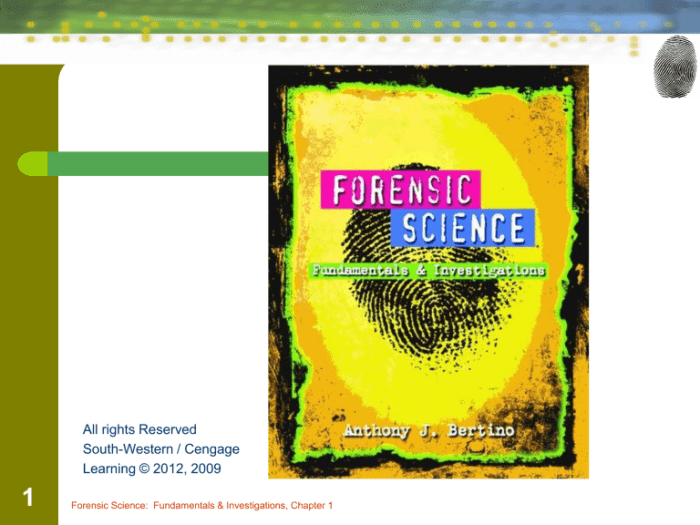Forensic science, the captivating field that bridges science and law, unveils the intricacies of crime scene investigations and provides invaluable insights for legal proceedings. This comprehensive guide, “Forensic Science: Fundamentals and Investigations,” delves into the core principles, methodologies, and ethical considerations that underpin this multifaceted discipline.
From the meticulous examination of crime scenes to the cutting-edge techniques employed in forensic analysis, this discourse explores the diverse branches of forensic science and their profound impact on modern-day investigations. Embark on an enlightening journey into the realm of forensic science, where scientific rigor meets the pursuit of justice.
Forensic Science Fundamentals
Forensic science is the application of scientific methods and techniques to legal problems and criminal investigations. It has a long history, dating back to the early days of human civilization.
The different branches of forensic science include:
- Forensic pathology
- Forensic toxicology
- Forensic anthropology
- Forensic odontology
- Forensic psychiatry
- Forensic engineering
- Forensic ballistics
- Forensic document examination
- Forensic photography
- Digital forensics
The scientific method is a systematic approach to problem-solving that is used in forensic investigations. It involves the following steps:
- Observation
- Hypothesis
- Experimentation
- Analysis
- Conclusion
Crime Scene Investigation: Forensic Science: Fundamentals And Investigations
Crime scene investigation is the process of collecting and analyzing evidence from a crime scene. It is a complex and challenging process that requires specialized training and experience.
The steps involved in a crime scene investigation include:
- Securing the scene
- Documenting the scene
- Searching for evidence
- Collecting evidence
- Preserving evidence
Proper evidence collection and preservation is essential to ensure that the evidence is admissible in court. Evidence that is not properly collected or preserved may be excluded from trial, which could result in a miscarriage of justice.
Technology plays an important role in crime scene investigations. For example, lasers can be used to detect fingerprints and DNA can be used to identify suspects.
Forensic Analysis

Forensic analysis is the process of examining and interpreting evidence from a crime scene. It is a complex and time-consuming process that requires specialized training and experience.
The different types of forensic analysis include:
- DNA analysis
- Fingerprint analysis
- Ballistics analysis
- Trace evidence analysis
- Digital forensics
DNA analysis is one of the most powerful tools available to forensic scientists. It can be used to identify suspects, exonerate the innocent, and determine the biological relationships between individuals.
Fingerprint analysis is another important forensic tool. Fingerprints are unique to each individual, and they can be used to identify suspects and link them to crime scenes.
Ballistics analysis is the study of firearms and ammunition. It can be used to determine the type of firearm that was used to fire a bullet, and it can also be used to identify the shooter.
Trace evidence analysis is the study of small pieces of evidence that can be found at a crime scene. Trace evidence can include things like fibers, hairs, and glass fragments. It can be used to link suspects to crime scenes and to determine the sequence of events that occurred during a crime.
Digital forensics is the study of digital evidence. It can be used to recover data from computers, cell phones, and other electronic devices. Digital forensics can be used to investigate a wide range of crimes, including computer hacking, fraud, and child pornography.
Forensic Reporting and Testimony

Forensic reports are written documents that summarize the findings of a forensic investigation. They are typically used to provide information to law enforcement officers, prosecutors, and defense attorneys.
Forensic experts may also be called to testify in court about their findings. When testifying, forensic experts must be able to clearly and concisely explain their findings and the methods they used to reach their conclusions.
Forensic reporting and testimony are essential to the criminal justice system. They provide objective and scientific evidence that can help to convict the guilty and exonerate the innocent.
Ethical Considerations in Forensic Science

Forensic scientists have a duty to uphold the highest ethical standards. They must be objective and impartial in their work, and they must avoid any conflicts of interest.
The following are some of the ethical principles that guide forensic scientists:
- Objectivity
- Impartiality
- Confidentiality
- Accuracy
- Integrity
Forensic scientists must also be aware of the potential for bias in their work. Bias can be caused by a variety of factors, including personal beliefs, prejudices, and financial interests.
Forensic scientists must take steps to avoid bias in their work. They must be aware of their own biases and they must take steps to minimize the impact of bias on their work.
Emerging Trends in Forensic Science
Forensic science is constantly evolving. New technologies are being developed all the time that are changing the way forensic investigations are conducted.
Some of the latest advancements in forensic science technology include:
- DNA sequencing
- Fingerprint analysis
- Ballistics analysis
- Trace evidence analysis
- Digital forensics
These new technologies are making it possible to solve crimes that were once unsolvable. They are also helping to improve the accuracy and reliability of forensic evidence.
The future of forensic science is bright. New technologies are being developed all the time that are making it possible to solve crimes in ways that were once unimaginable.
Commonly Asked Questions
What is the primary objective of forensic science?
The primary objective of forensic science is to provide scientific analysis and expert testimony in legal proceedings, assisting in the investigation and resolution of crimes.
How does forensic science contribute to crime scene investigations?
Forensic science plays a vital role in crime scene investigations by meticulously examining physical evidence, analyzing trace materials, and reconstructing events to uncover crucial details that aid in identifying suspects and determining the circumstances of the crime.
What are the ethical principles that guide forensic scientists?
Forensic scientists are bound by ethical principles that emphasize objectivity, impartiality, and the avoidance of bias and conflicts of interest. They are committed to maintaining the integrity of evidence and providing unbiased expert opinions based solely on scientific findings.